OZ1. Strange Happenings
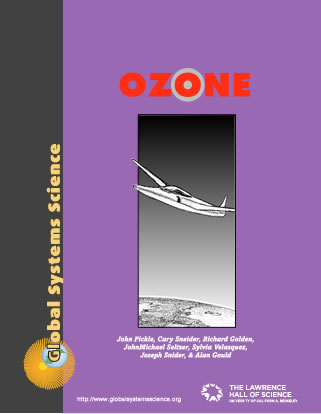
Chapter 1
{ Ozone Contents }
Something strange is happening…
There is the possibility of danger…
Unknown forces are at work, but there are clues …
These are the elements of a mystery, a mystery that cries out for investigation. Solving mysteries is exciting, and it is at the core of what the scientific endeavor is all about.
In 1985, Joe Farman of the British Antarctic Survey Team discovered something strange happening over the South Pole. The amount of ozone gas high in the atmosphere was drastically diminishing each spring (September to December in the Southern Hemisphere) and seemed to be making a comeback through the summer and fall. Data from previous years indicated that the amount of spring loss was increasing each year.

There was plenty of danger in the situation. If the layer of ozone was actually thinning it would let more of the deadly ultraviolet rays of the Sun penetrate to the Earth’s surface. If the ozone depletion were to extend over other parts of the Earth, there would be extreme potential for global disaster. Also dangerous was the investigation itself. To find out what was happening required moving into severely inhospitable territory. Still there were many questions that needed answers. What was the extent of the thinning? What was causing it? Why was it happening over the South Pole? Would the thinning spread to the rest of the world’s ozone layer? The mystery was a challenging one.
What is ozone?
Ozone is a molecule that has 3 oxygen atoms instead of the molecule of 2 oxygen
atoms which we must breath to live.
I. At Punta Arenas, Chile, August 1987
In an airport hanger of the Chilean Air Force in the town of Punta Arenas at the southernmost tip of South America are two American planes. One of them is a converted DC-8 jet passenger plane, known for its dependability. The cruising altitude of the DC-8 is 10.5 kilometers (35,000 feet), but can reach altitudes up to 12.4 km (41,000 ft). The other plane is an ER-2, an advanced design high altitude aircraft similar to the U-2 developed originally for military aerial reconnaissance. The ER-2 is a single-seat aircraft that can fly at altitudes over 20 kilometers (66,000 feet) above the Earth where the air is very thin.
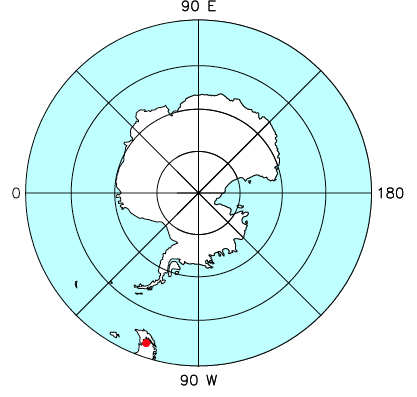
Map of Antarctica and the southern tip of South America, showing the location of Punta Arenas, Chile. (Courtesy of Peter Nelson, Atmospheric and Environmental Research, Inc.)
A small laboratory is set up on board each plane to sample the atmosphere and measure the chemicals that might change before they can be analyzed back on the ground. Four retired U.S. Air Force pilots take turns flying the planes simultaneously at two different altitudes on twelve missions.
National Aeronautics and Space Administration (NASA) scientists have set up a laboratory in a corner of the hanger. They are waiting to do additional analysis of the air samples collected over the South Pole to determine the chemical composition of stable molecules. Making measurements of the atmosphere’s chemistry is very difficult. First, getting to the stratosphere high above the ground is a daunting task. Then, collecting accurate, representative air samples is difficult to do from a fast moving airplane.
In this case, the laboratory itself must come along since some molecules may react very quickly with other chemicals to form a new chemical, especially when removed from that particular environment which has a specific temperature, pressure, sunlight level, and chemical components. Over the Antarctic, the conditions are extremely hazardous: colder and windier than any other place airplanes have ever flown. The flight crews will face temperatures as low as -90°C and winds as high as 115 miles per hour. They will fly over territory where there are no emergency airfields.

The director of the project is an atmospheric chemist from NASA, Dr. Robert Watson. He and his team have ideas of what to look for, but they are keeping an open mind about the cause of the ozone depletion. Research conducted at the McMurdo Station in the Antarctic the year before found the presence of chlorine gas in the polar atmosphere. That would indicate a chemical cause of the ozone depletion. However, the chlorine gas might be a natural occurrence. On the other hand, man-made chemicals may be destroying ozone.
Dr. Robert Watson.
(Photo courtesy of the World Bank.)
II. Through the Layers of the Atmosphere
At dawn both planes take off to begin their data collection over Antarctica. The DC-8 is loud and powerful. The ER-2 has long, fragile-looking wings that flex up and down as it starts to taxi along the runway. They seem in danger of breaking off! The plane struggles to lift its heavy fuel supply into the air. It manages, and the planes head off on their important missions.

The planes move rather slowly through the dense sea-level atmosphere. Most planes are built to travel at high altitudes where the air is thinner. The gravity of the Earth not only holds the planes back; it also compresses the atmosphere so that it is most dense close to the surface. Ninety percent of the Earth’s air is within 10–12 kilometers from the surface.

As the aircraft climb, the air temperature changes around them. Examine the figure on the following page to see which two layers of the atmosphere will be studied during this experiment.
ER-2 Single seat aircraft. Used for measuring ozone concentrations in the lower stratosphere, 20 km high. (Photo courtesy of NASA)
Layers of the Atmosphere
One way to classify layers of the atmosphere is by the amount of temperature change with height. Names ending in “sphere” are layers of the atmosphere with temperature either increasing or decreasing with height, and those ending in “pause” are transition zones in which temperature remains constant with height.
Troposphere
The troposphere extends from sea level to an altitude of about 11 km, depending on latitude and season of the year. At the equator, where the Sun’s heating expands the troposphere, the layer extends up to 16 km. At the poles, where the air is colder and hence denser, the troposphere may extend to only 9 km. The thickness of the troposphere increases during the summer months due to increased heating, and contracts during the winter months.
A key feature of the troposphere is cooling with height. The temperature cools by 6.5ºC with each kilometer gain in altitude (-6.5ºC/km). Within the thin layer of air adjacent to the Earth’s surface, this rate is rarely observed due to the ever-changing temperature of the Earth’s surface throughout the day and night. The average temperature at the top of the troposphere is roughly -55°C.
One of the main qualities of the troposphere is that it smooths out the effects of the Sun’s uneven heating of the Earth’s surface. The name troposphere is derived from the Greek word “tropein”, which means to turn or change. Air molecules within energetic weather patterns can travel to the top of the troposphere and back down again in just a few days.
Tropopause
The troposphere is capped by the tropopause, a layer about 1 km thick in which the temperature does not change with height. What stops the temperature from decreasing with height? The layer of ozone-rich air lying just above the tropopause.
Stratosphere
Above the tropopause, the stratosphere extends from 12 to 50 km in altitude and is characterized by air temperature increasing with height. Increasing temperature with altitude creates a stabilizing effect on the stratosphere, effectively capping the churning and turbulence of the troposphere. The stratosphere behaves as a stable layer, or strata, of air (hence, the term stratosphere) having little vertical motion.
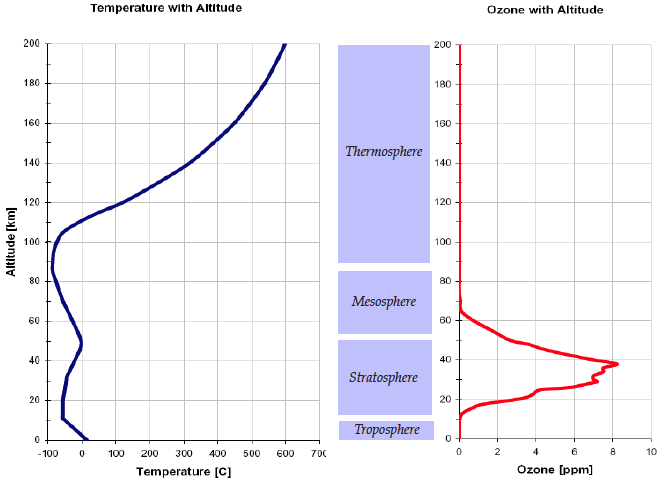
The stratosphere’s temperature is a result of its chemical composition, specifically, the large concentration of ozone which captures a portion of the energy from the Sun and converts it to heat. Approximately 90% of the atmosphere’s ozone is in the stratosphere, with concentrations up to 11 parts per million (ppm) by volume as compared to roughly 0.04 ppm by volume in the troposphere. Most of the ozone molecules are in a region of the stratosphere between 20 and 50 km above the Earth’s surface.
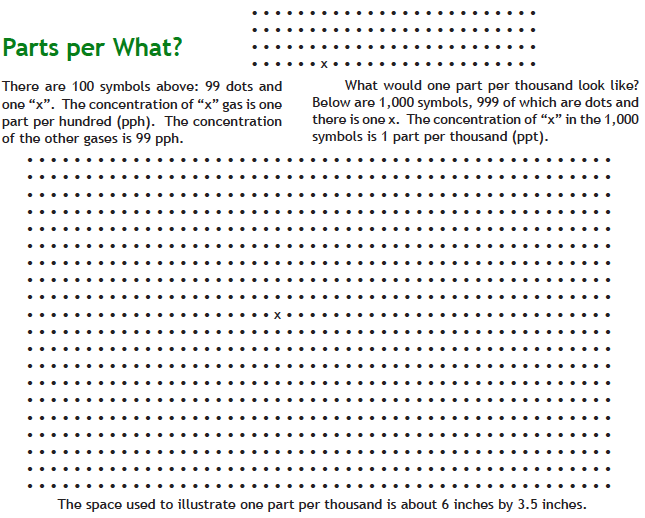
Stratopause
The stratopause is the thin layer of constant temperature between the stratosphere and the mesosphere.
Mesosphere
The mesosphere is the middle layer in the atmosphere extending between 50 km and 85 km. Because this layer contains so few atoms and molecules that absorb the Sun’s energy, such as ozone, it is very cold. At the top of the mesosphere, air temperature reaches its coldest value, around -90ºC.
The air is extremely thin at this level. Over 99.9% of the atmosphere’s mass lies below the mesosphere.
Interestingly, the proportion of nitrogen and oxygen at these levels is about the same as at sea level. Despite the low density of air molecules, this is where meteoroids that fall to the Earth burn up in the atmosphere due to the friction from collisions with gas molecules. People sometimes refer to the resulting streak of light as a shooting star.
Mesopause
The mesopause is the thin layer of near constant temperature between the mesosphere and the thermosphere.
Thermosphere
The thermosphere is the warm layer above the mesosphere, extending from 90 to 500 km altitude. The temperature increases with altitude in this layer. The thermosphere has mostly lighter molecules, such as atomic oxygen, hydrogen, and helium. These molecules are heated by the energy coming from the Sun to temperatures exceeding 1500ºC. The type of solar radiation that heats the molecules in the thermosphere has a different wavelength compared to the radiation that breaks up ozone molecules and heats the stratosphere. This portion of the Sun’s radiation is absorbed in the thermosphere and is not available to heat the molecules in the mesosphere below.
Even though the measured temperature of individual molecules is very hot, skin exposed in the thermosphere would feel very cold. There are not enough molecules bombarding your skin to transfer enough heat to feel the actual temperature of the molecules.
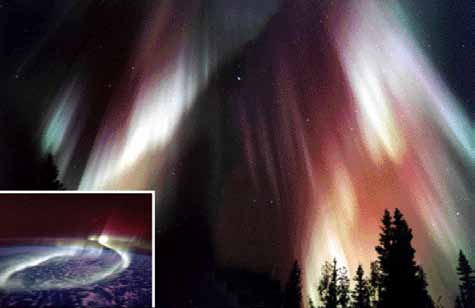
You may have heard of the aurora, or northern lights. These occur in the thermosphere when charged particles from the Sun are captured by the Earth’s magnetic field and rain down into the thermosphere, creating moving, shimmering curtains of colorful light.
Within the thermosphere is the ionosphere, a layer of electrically charged (ionized) molecules. Intense solar radiation strips away electrons from the gas molecules to create ions. This layer reflects radio waves back to the Earth’s surface allowing communication over thousands of miles.
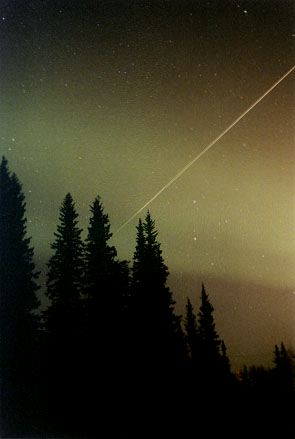
Exosphere
The exosphere is the uppermost layer of the atmosphere where molecules can overcome the pull of gravity and escape into outer space. Here, the Earth’s atmosphere slowly diffuses into the void of space. The exosphere usually begins at roughly 500 km, but there is no definable boundary to mark the end of the thermosphere and the beginning of the exosphere. It extends to over 64,000 km above the earth’s surface.
Question 1.2:
Which “sphere” or “pause” of the atmosphere do commercial airplanes fly in?
The Results of the Flights
The opportunity to move into uncharted territory to gain important new knowledge is what drives people in science to sometimes face harsh conditions and possibly risk their lives. This time the effort paid off. After long hours of flight over the vast white wilderness, the planes returned safely to base. The measurements from instruments onboard both planes from their multiple flights showed that the so-called “ozone hole” was real. The reduction in ozone concentrations was about 50%, and it was confined to the stratosphere above the South Pole. But the area of depletion was surprisingly large. It covered an area larger than the United States and half of Canada. The other result of the investigation confirmed the findings of a ground expedition the year before concerning the chemical makeup of the air in the ozone-depleted area. It contained chlorine.
This research effort was the result of the cooperation of about 170 people that included scientists, pilots, engineers, lab technicians, mechanics, and aircraft maintenance crews. The project accomplished its mission by establishing the size of the area of ozone depletion and its magnitude.

